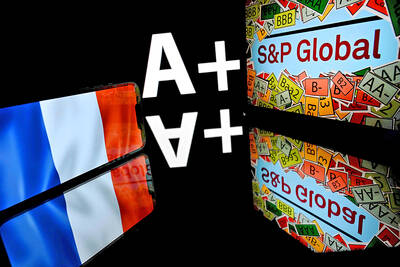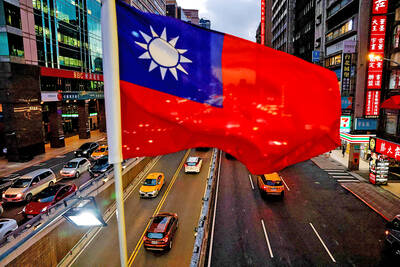China surpassed the US to become the world’s biggest trading nation last year as measured by the sum of exports and imports, a milestone in the Asian nation’s challenge to the US’ dominance in global commerce that emerged after the end of World War II in 1945.
US exports and imports last year totaled US$3.82 trillion, the US Commerce Department said last week. China’s customs administration reported last month that the country’s total trade last year amounted to US$3.87 trillion. China had a US$231.1 billion annual trade surplus, while the US had a trade deficit of US$727.9 billion.
China’s emergence as the biggest global trading nation gives it increasing influence, threatening to disrupt regional trading blocs as it becomes the most important commercial partner for countries including Germany, which will export twice as much to China by the end of the decade as it does to neighboring France, Goldman Sachs Group Inc’s Jim O’Neill said.
“For so many countries around the world, China is becoming rapidly the most important bilateral trade partner,” O’Neill, chairman of Goldman Sachs’ asset management division and the economist who bound Brazil to Russia, India and China to form the BRIC investing strategy, said in a telephone interview. “At this kind of pace by the end of the decade many European countries will be doing more individual trade with China than with bilateral partners in Europe.”
Still, the US economy is more than double the size of China’s, according to the World Bank. In 2011, the US’ GDP reached US$15 trillion, while China’s totaled US$7.3 trillion.
“It is remarkable that an economy that is only a fraction of the size of the US economy has a larger trading volume,” Nicholas Lardy, a senior fellow at the Peterson Institute for International Economics in Washington, said in an e-mail.
“The surpassing of the US is not because of a substantially undervalued currency that has led to an export boom,” Lardy said, adding that Chinese imports have grown more rapidly than exports since 2007.
China became the world’s biggest exporter in 2009, while the US remains the biggest importer, taking in US$2.28 trillion in goods last year, compared with China’s US$1.82 trillion in imports.
HSBC Holdings PLC forecast last year that China would overtake the US as the top trading nation by 2016.
While China is the biggest energy user, has the world’s biggest car market and the world’s largest foreign currency reserves, a significant portion of China’s trade involves importing raw materials and parts to be assembled into finished products and re-exported, an activity that provides “only modest value added,” Eswar Prasad, a former IMF official who is now a professor at Cornell University in Ithaca, New York, said in an e-mail.
The US’ bilateral trade deficit with China, which peaked last year, could remain a flashpoint of tension between the two countries, Prasad said.
“This trade imbalance is not representative of the amount of goods actually produced in China and exported to the US, but this perspective tends to get lost amidst the heated political rhetoric in the US,” Prasad said.
According to O’Neill, the trade figures underscore the need to draw China further into the global financial and trading architecture that the US helped create.
“One way or another we have to get China more involved in the global organizations of today and the future despite some of their own reluctance,” O’Neill said, mentioning China’s inclusion in the IMF’s Special Drawing Rights currency basket. “To not have China more symbolically and more importantly actually central to all these things is just increasingly silly.”

Jensen Huang (黃仁勳), founder and CEO of US-based artificial intelligence chip designer Nvidia Corp and Taiwan Semiconductor Manufacturing Co (TSMC, 台積電) on Friday celebrated the first Nvidia Blackwell wafer produced on US soil. Huang visited TSMC’s advanced wafer fab in the US state of Arizona and joined the Taiwanese chipmaker’s executives to witness the efforts to “build the infrastructure that powers the world’s AI factories, right here in America,” Nvidia said in a statement. At the event, Huang joined Y.L. Wang (王英郎), vice president of operations at TSMC, in signing their names on the Blackwell wafer to

France cannot afford to ignore the third credit-rating reduction in less than a year, French Minister of Finance Roland Lescure said. “Three agencies have downgraded us and we can’t ignore this cloud,” he told Franceinfo on Saturday, speaking just hours after S&P lowered his country’s credit rating to “A+” from “AA-” in an unscheduled move. “Fundamentally, it’s an additional cloud to a weather forecast that was already pretty gray. It’s a call for lucidity and responsibility,” he said, adding that this is “a call to be serious.” The credit assessor’s move means France has lost its double-A rating at two of the

AI BOOST: Although Taiwan’s reliance on Chinese rare earth elements is limited, it could face indirect impacts from supply issues and price volatility, an economist said DBS Bank Ltd (星展銀行) has sharply raised its forecast for Taiwan’s economic growth this year to 5.6 percent, citing stronger-than-expected exports and investment linked to artificial intelligence (AI), as it said that the current momentum could peak soon. The acceleration of the global AI race has fueled a surge in Taiwan’s AI-related capital spending and exports of information and communications technology (ICT) products, which have been key drivers of growth this year. “We have revised our GDP forecast for Taiwan upward to 5.6 percent from 4 percent, an upgrade that mainly reflects stronger-than-expected AI-related exports and investment in the third

RARE EARTHS: The call between the US Treasury Secretary and his Chinese counterpart came as Washington sought to rally G7 partners in response to China’s export controls China and the US on Saturday agreed to conduct another round of trade negotiations in the coming week, as the world’s two biggest economies seek to avoid another damaging tit-for-tat tariff battle. Beijing last week announced sweeping controls on the critical rare earths industry, prompting US President Donald Trump to threaten 100 percent tariffs on imports from China in retaliation. Trump had also threatened to cancel his expected meeting with Chinese President Xi Jinping (習近平) in South Korea later this month on the sidelines of the APEC summit. In the latest indication of efforts to resolve their dispute, Chinese state media reported that